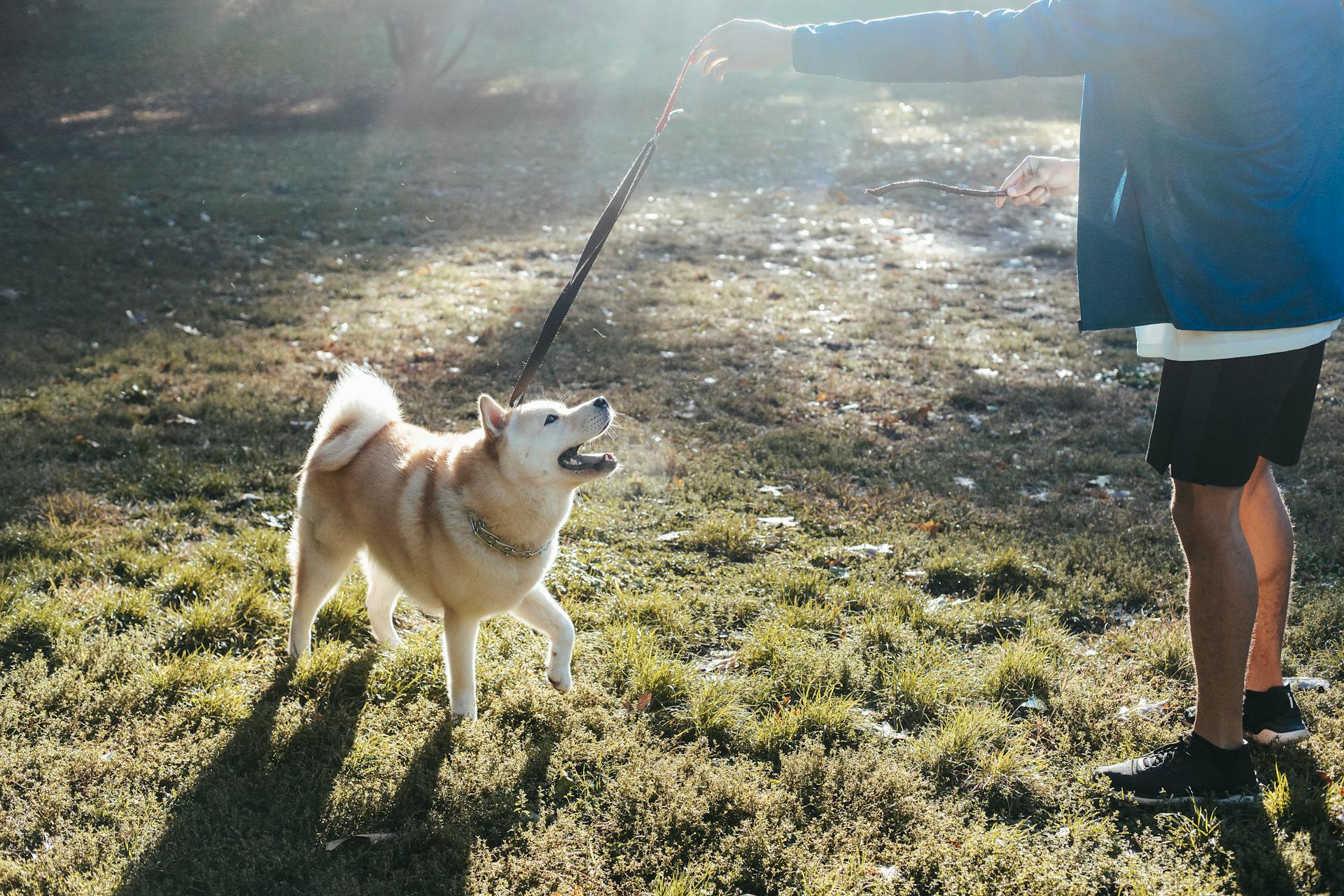
Earning a dog training certification can open doors to new career opportunities and increase your credibility as a trainer. To become certified, you'll need to meet the requirements set by a certifying organization, such as the Certification Council for Professional Dog Trainers (CCPDT).
The CCPDT offers two levels of certification: Certified Professional Dog Trainer (CPDT) and Certified Professional Dog Trainer - Knowledge Assessed (CPDT-KA). To qualify for the CPDT, you'll need to have at least 300 hours of training experience and pass a written exam. The CPDT-KA requires a bachelor's degree in a relevant field or 300 hours of experience, plus a written exam.
Broaden your view: Training to Be a Guide Dog Trainer
Why Become Certified?
Becoming certified as a dog trainer can bring you a sense of personal satisfaction, knowing you've met rigorous standards for knowledge and skills in science-based dog training.
Certification also motivates you to continue learning and staying current on the latest science and techniques in the field, which can be a great asset for your professional development.
Having a certification can give you a marketing edge, especially when you educate your clients and prospects about it. It's a way to stand out from others in the industry.
Certification is a step towards professionalizing the field of dog training, where only qualified professionals are recognized as experts.
Here are some benefits of certification:
- Personal satisfaction from meeting rigorous standards
- Continuing education and staying current on the latest techniques
- Marketing edge and standing out in the industry
- Professionalizing the field of dog training
Certification is not just about personal benefits, but also about contributing to the growth and credibility of the dog training industry.
Certification Programs
If you're interested in becoming a certified dog trainer, you have several options to consider. The Animal Behavior College (ABC) offers a comprehensive online program that can be completed in stages.
You'll start by learning the basics of dog behavior and training principles, including the LIMA (least intrusive, minimally aversive) approach and the Humane Hierarchy. This foundation is crucial for building a strong understanding of dog training.
The program is divided into 11 stages, each covering a specific aspect of dog training. You'll learn about training tools, basic obedience cues, and problem-behavior solving. You'll also gain hands-on experience through a mentorship program and animal shelter volunteer work.
A different take: 6 Week Dog Training Program
Upon completion of the program, you'll receive your ABC Certified Dog Trainer (ABCDT) certification. This certification is recognized in the industry and can open doors to various career opportunities.
Here's a breakdown of the program's stages:
The program also prepares you for other independent certifications, including the Certified Professional Dog Trainer-Knowledge Assessed (CPDT-KA) Certification.
Becoming a Trainer
To become a dog trainer, you'll need to gain hands-on experience and knowledge of science-based dog training methods. This can be achieved through programs that provide education, practical skills, and hands-on experience, such as the one mentioned in Example 3, which includes an externship portion where you'll work with a Mentor Trainer.
To get started, you'll need to meet the eligibility requirements for certification, which typically include being at least 18 years old, having a high school diploma or equivalent, and logging a minimum of 300 hours of experience in dog training within the last 3 years, as seen in Example 4.
Some programs, like the one described in Example 5, offer online dog obedience school courses that include valuable real-world experience, Pet CPR and First Aid Certification, and the opportunity to become an ABC Certified Dog Trainer (ABCDT).
A unique perspective: 3 Week Dog Training Camp
Cpdt - Ka
To become a Certified Professional Dog Trainer-Knowledge Assessed (CPDT-KA), you'll need to meet certain requirements. You must be at least 18 years old and have earned a high school diploma, GED, or equivalent.
The CPDT-KA certification is a rigorous process that evaluates your knowledge and skills in ethology, learning theory, dog training technique, and instruction. You'll need to log a minimum of 300 hours of experience in dog training within the last 3 years.
To be eligible for the exam, you'll also need to provide a signed Attestation Statement from a CCPDT certificant, veterinarian, or other approved professional. This ensures that you have the necessary experience and expertise to become a certified trainer.
The CPDT-KA exam consists of 200 multiple-choice questions and is administered at computer-based testing facilities throughout the U.S., internationally, and via remote proctoring.
Becoming a Trainer
To become a dog trainer, you'll need to have a solid foundation in science-based methods. Certification is available through organizations like the Certification Council for Professional Dog Trainers, but it's not required. To be eligible for the CPDT-KA exam, you'll need to log a minimum of 300 hours of experience in dog training within the last three years.
You'll also need to meet other requirements, such as being at least 18 years old and having a high school diploma or equivalent. Additionally, you'll need to provide a signed attestation statement from a CCPDT certificant, veterinarian, or other approved professional.
Hands-on experience is crucial in getting hired as a dog trainer. Many training programs include an externship portion, where you'll work with a mentor trainer and gain real-world experience. This will help you develop the skills and confidence you need to succeed in the field.
Here are some key skills and knowledge areas to focus on as you pursue your training:
- Learning theory and behavior modification techniques
- Training fundamentals and basic obedience cues
- Problem-solving and public speaking skills
- Business building and marketing strategies
Remember, becoming a dog trainer requires dedication, hard work, and a passion for working with dogs. By focusing on science-based methods and gaining hands-on experience, you'll be well on your way to a rewarding career in this field.
Setting Realistic Expectations
As a trainer, it's essential to set realistic expectations with your clients. Dog trainers aren't miracle workers, and behavior change takes time.
A single session can still be helpful in identifying the root causes of a dog's behavior and some initial ways to help them choose new behaviors. This can be especially important for those on a budget, as access to behavioral support can be pricey unless you have a low-cost option in your community.
If you only practice during training sessions, it's not going to stick, so a consistent approach is necessary to help dogs generalize the new behavior from the classroom to the home.
Remember, a trainer's goal is to help you develop a plan that works for you and your dog, not to promise overnight fixes.
Intriguing read: Do Dog Diapers Help with Potty Training
Frequently Asked Questions
How to become a dog trainer in Illinois?
To become a dog trainer in Illinois, take behavioral theory and behavior modification classes, and gain hands-on experience under an expert trainer. Consider apprenticing with a professional dog trainer to accelerate your learning and success.
How to become a certified dog trainer in Oklahoma?
To become a certified dog trainer in Oklahoma, consider enrolling in The Academy of Pet Careers' online or in-person certification programs, tailored to your learning goals. With APC, you can pursue a career in dog training with confidence and expertise.
What is the highest rated dog training certification?
The highest rated dog training certification is offered by the Certification Council for Professional Dog Trainers (CCPDT), recognized globally for its rigorous exams and high professional standards. This certification is a mark of excellence for dog trainers worldwide.
What is the highest level of dog training certification?
The highest level of dog training certification is the Boarded Behaviorist, which requires advanced degrees and extensive knowledge in behavioral health. Achieving this level demonstrates expertise in canine behavior and training.
How to become a dog trainer in MD?
To become a dog trainer in Maryland, gain hands-on experience through volunteering or working with a professional trainer, and then enroll in a certification program. This combination of knowledge and experience will prepare you for a successful career in dog training.
Sources
- https://www.ccpdt.org/certification/dog-trainer-certification/
- https://www.animalbehaviorcollege.com/dog-trainer/
- https://www.animalhumanesociety.org/behavior/becoming-dog-trainer
- https://www.humanesociety.org/resources/how-find-dog-trainer
- https://www.akc.org/products-services/training-programs/canine-good-citizen/
Featured Images: pexels.com


